
The ferns are a group of vascular plants that reproduce via spores and have neither seeds nor flowers. They differ from mosses by being vascular, i.e., having specialized tissues that conduct water and nutrients and in having life cycles in which the branched sporophyte is the dominant phase.
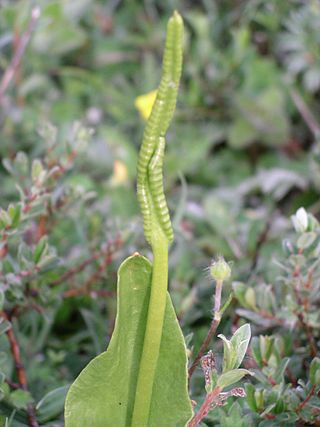
Ophioglossaceae, the adder's-tongue family, is a small family of ferns. In the Pteridophyte Phylogeny Group classification of 2016, it is the only family in the order Ophioglossales, which together with the Psilotales is placed in the subclass Ophioglossidae. The Ophioglossidae are one of the groups traditionally known as eusporangiate ferns. Members of the family differ from other ferns in a number of ways. Many have only a single fleshy leaf at a time. Their gametophytes are subterranean and rely on fungi for energy.

Botrychium is a genus of ferns, seedless vascular plants in the family Ophioglossaceae. Botrychium species are known as moonworts. They are small, with fleshy roots, and reproduce by spores shed into the air. One part of the leaf, the trophophore, is sterile and fernlike; the other, the sporophore, is fertile and carries the clusters of sporangia or spore cases. Some species only occasionally emerge above ground and gain most of their nourishment from an association with mycorrhizal fungi.

Sceptridium is a genus of seedless vascular plants in the family Ophioglossaceae, closely allied to the genus Botrychium. It is also closely related to the genus Botrypus. Sceptridium species are commonly called the grape-ferns.
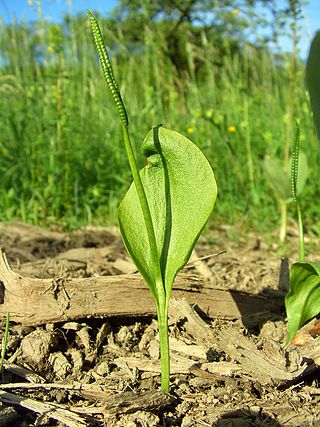
Ophioglossum vulgatum, commonly known as adder's-tongue, southern adder's-tongue or adder's-tongue fern, is a species of fern in the family Ophioglossaceae.

Botrypus virginianus, synonym Botrychium virginianum, sometimes called rattlesnake fern is a species of perennial fern in the adders-tongue family. It is monotypic within the genus Botrypus, meaning that it is the only species within the genus. It is called the rattlesnake fern in some parts of North America, due to its habit of growing in places where rattlesnakes are also found. Rattlesnake fern prefers to grow in rich, moist woods in dense shade and will not tolerate direct sunlight.
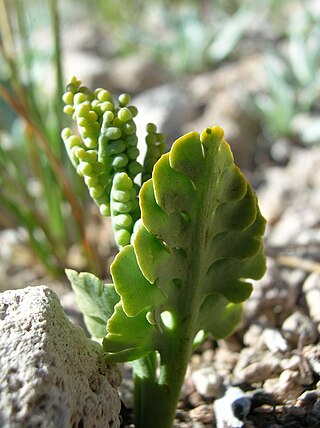
Botrychium pumicola, with the common name pumice moonwort, is a rare fern.

Sceptridium multifidum is a fern species in the Ophioglossaceae, known by the common names leathery grapefern and leathery moonwort.

Botrychium ascendens is a species of fern in the family Ophioglossaceae known by the common names triangle-lobe moonwort and upswept moonwort. It is native to North America from British Columbia to northern California as well as parts of eastern Canada. It lives in different habitat types, including grassy riverside areas. This is very small plant growing from an underground caudex and sending one yellow-green leaf above the surface of the ground. The leaf is up to 6 centimeters tall and is divided into a sterile and a fertile part. The sterile part of the leaf has fan-shaped or wedge-shaped leaflets. The fertile part of the leaf is very different in shape, with tiny grapelike clusters of sporangia by which it reproduces.

Botrychium crenulatum is a species of fern in the family Ophioglossaceae known by the common names scalloped moonwort and dainty moonwort. It is native to North America from British Columbia to California to Wyoming, where it is uncommon throughout most of its range, appearing incidentally at scattered spots on wet meadows in coniferous forests and marshy areas such as swamps. This is very small plant growing from an underground caudex and sending one thin, shiny, yellow-green leaf above the surface of the ground. The leaf is up to about 6 centimeters tall and is divided into a sterile and a fertile part. The sterile part of the leaf has veined, fan-shaped leaflets with wrinkly edges. The fertile part of the leaf is very different in shape, with tiny grapelike clusters of sporangia by which it reproduces.

Botrychium minganense is a species of fern in the family Ophioglossaceae known by the common name Mingan moonwort. It is native to North America from Alaska and northern Canada to Arizona, where it is uncommon throughout most of its range, appearing at scattered spots in coniferous forests and marshy areas such as swamps.

Botrychium montanum is a species of fern in the family Ophioglossaceae known by the common names western goblin and mountain moonwort. It is native to western North America from British Columbia to northern California to Montana, where it grows in the dark understory of coniferous forests and other moist wooded areas. This is very small plant growing from an underground caudex and sending one thin gray-green leaf above the surface of the ground. The leaf is less than 8 centimeters tall and is divided into a sterile and a fertile part. The sterile part of the leaf has irregularly shaped angled leaflets. The fertile part of the leaf is very different in shape, with grapelike clusters of sporangia by which it reproduces.

Botrychium pinnatum is a species of fern in the family Ophioglossaceae, known by the common name northwestern moonwort. It is native to North America from Alaska to northern Canada to California and Arizona, where it is generally scattered and uncommon, growing in coniferous forests and grassy meadows. This is very small plant growing from an underground caudex and sending one thin, shiny, green leaf above the surface of the ground. The leaf is less than 8 centimeters tall and is divided into a sterile and a fertile part. The flat sterile part of the leaf has oval to widely lance-shaped leaflets. The fertile part of the leaf is very different in shape, with grapelike clusters of sporangia by which it reproduces.

Sceptridium dissectum is a common fern in the family Ophioglossaceae, occurring in eastern North America. Like other plants in this group, it normally only sends up one frond per year. It has long been the subject of confusion because the frond presents in one of two forms, either the normal form that resembles other plants in the genus, or the skeletonized form.
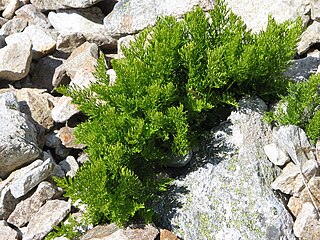
Cryptogramma crispa, the parsley fern, is an Arctic–alpine species of fern. It produces separate sterile and fertile fronds, up to 30 cm (12 in) tall, and is a pioneer species on acidic screes.

Botrychium boreale, commonly called northern moonwort, is a species of fern in the family Ophioglossaceae. It is a short, single leaved rhizome that stands upright.

Botrychium matricariifolium is a species of fern in the Ophioglossaceae family. It is referred to by the common names chamomile grape-fern, daisyleaf grape-fern, and matricary grape-fern. It is native to Europe and parts of eastern North America, including eastern Canada and parts of the United States.
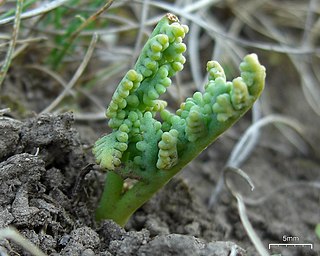
Botrychium paradoxum is a species of fern in the family Ophioglossaceae known by the common name peculiar moonwort. It is native to North America, where there are scattered occurrences in Alberta, British Columbia, Saskatchewan, Montana, Oregon, Utah, Washington, and Wyoming.
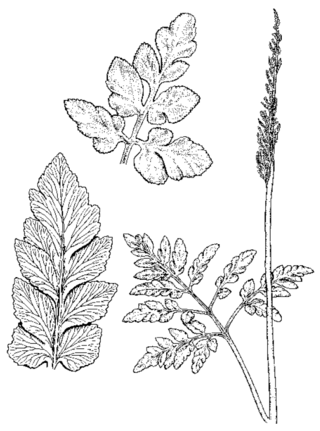
Sceptridium oneidense, the blunt-lobed grapefern, is a fern species in the family Ophioglossaceae.

Botrychium campestre is a fern species in Ophioglossaceae, commonly called prairiemoonwort, prairie dunewort, Iowa moonwort, or plains grapefern. It was first discovered in 1982 and described a few years later.






















